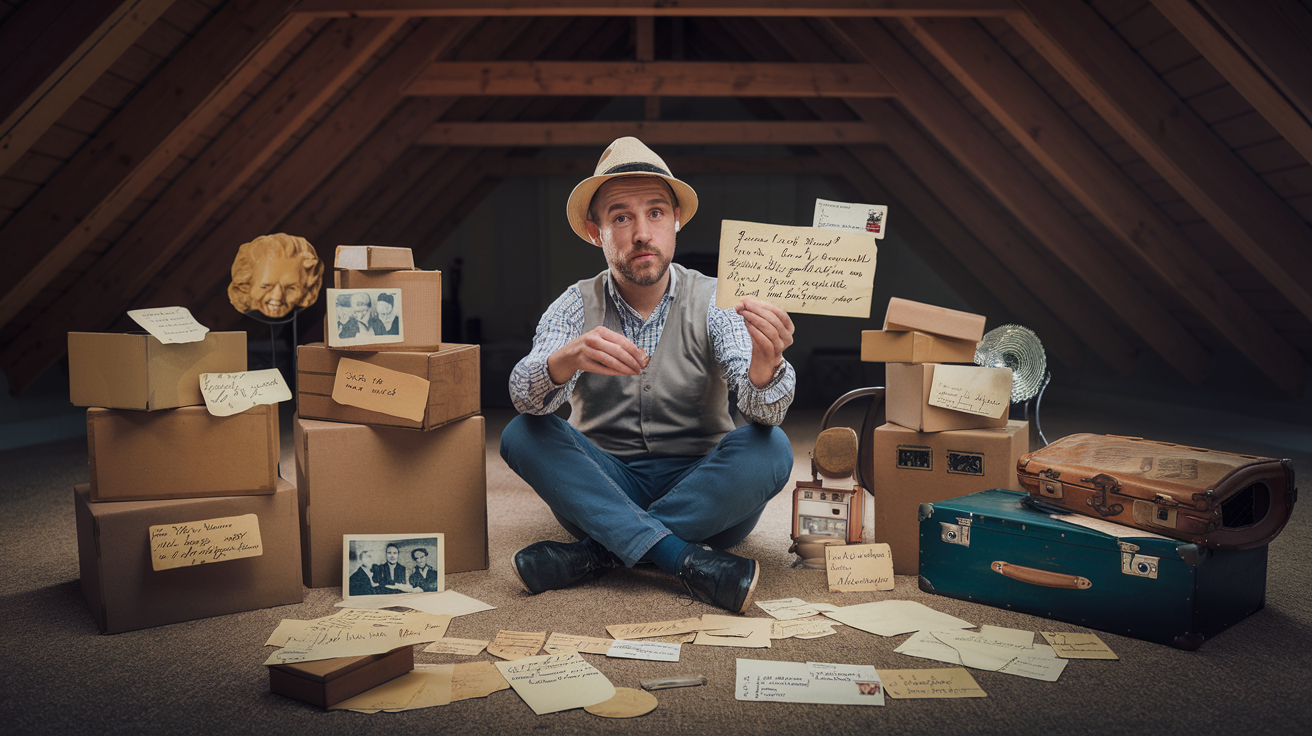You’re missing out. Big time.
Your family history is hiding. In plain sight. Where? Old postcards and letters. These forgotten gems hold secrets. Waiting to be uncovered.
Genealogy isn’t just names and dates. It’s stories. Lives lived. And these personal communications?
They’re goldmines.
Think about it. Your great-grandfather’s handwriting. Your grandmother’s childhood thoughts. All preserved. On paper. Ready to tell their tales.
We’re about to dive deep. Into the world of unexpected genealogy sources. You’ll never look at that dusty shoebox in the attic the same way again.
The Hidden Treasure Trove: Why Postcards and Letters Matter
Think back. Before smartphones. Before email. People wrote. A lot.
Letters were lifelines. Postcards? Little snippets of life. Frozen in time.
In 1900, Americans sent 7 billion pieces of mail. That’s 88 per person. Per year. Imagine the stories. The details. The clues.
These aren’t just paper. They’re portals. To another era. Your ancestors’ era.
They fill gaps. Connect dots. Bring your family tree to life.
A census tells you where. A birth certificate tells you when. But a letter? It tells you why. How. What it felt like.
That’s the power of personal correspondence. It’s history. Unfiltered. Unedited. Straight from the source.
Uncovering Family Connections
Ever heard of Great-Aunt Mildred? No? Your postcards might know her.
Signatures reveal. Salutations uncover. Relationships emerge.
Example: A faded postcard. Signed “Your loving Aunt Millie”. Boom. New branch on your tree.
But it’s not just about names. It’s about connections. Relationships. The family web.
Analyze every word. “Dearest Nephew” could be your missing link. “Give my love to cousin Sarah” – who’s Sarah? Time to dig deeper.
Pro tip: Create a list. Every name mentioned. Even in passing. You never know which one will crack your case wide open.
Remember: Families change. Nicknames evolve. “Buddy” in one letter might be “Robert” in official records. Stay sharp. Connect the dots.
Piecing Together Migration Patterns
Postmarks tell stories. Addresses paint pictures.
Your family moved. But where? When? Let the letters guide you.
Case study: The Johnsons. Five postcards. Five cities. One family’s westward journey mapped out.
1910: New York City. 1912: Chicago. 1915: Omaha. 1918: Denver. 1920: San Francisco.
Each postmark? A breadcrumb. Leading you through history. Through your family’s story.
But don’t stop there. Why did they move? Look for clues. “Pa’s new job at the railroad” – bingo. You’ve got motive.
Pro tip: Cross-reference with census records. Double the insight. Half the guesswork.
And remember: Addresses change. Streets get renamed. Cities grow. Use historical maps. Pinpoint exact locations. Walk in your ancestors’ footsteps.
Glimpses into Daily Life
“Pa got a new Model T.” More than just a casual mention. It’s a time capsule.
Occupations. Hobbies. Living conditions. All hiding in plain text.
“It’s been a hard winter.” Suddenly, your ancestors’ struggles become real.
Dated expressions confuse you? Good. They’re clues. “23 skidoo” – welcome to the 1920s.
Read between the lines. “Mary’s cough is better” – was there a TB outbreak? Time to check local health records.
Every detail matters. “Eggs are 10 cents a dozen” – that’s economic history. Right there. In your hands.
Don’t just read. Visualize. Immerse yourself. You’re not just researching. You’re time traveling.
Solving Family Mysteries
Family legends. Every family has them. But are they true?
Example: The lost inheritance. Whispered about for generations. No proof. Until now.
An old letter surfaces. “Regret to inform you… Uncle John’s estate… legal complications.”
Suddenly, the legend has teeth. Time to dig. Probate records. Newspaper archives. The chase is on.
But it’s not always about big reveals. Sometimes, it’s the little mysteries. Why did Grandma never talk about her sister? A tear-stained letter holds the answer.
Remember: Every family has secrets. Letters and postcards? They’re secret-keepers. And secret-revealers.
Your job? Be a detective. Follow the paper trail. Uncover the truth.
Identifying Historical Photographs
That old photo album. Full of nameless faces. Frustrating, right? Not anymore.
Enter: The picture postcard. Your new best friend.
Here’s why: Postcards were mass-produced. Dated. Localized. They’re time stamps. And place stamps.
Got a family photo with a building in the background? Find a postcard of that building. Date your photo. Locate your ancestors.
But don’t stop there. Clothing styles. Car models. Street signs. Every detail is a clue.
Pro tip: Create a timeline. Photos on one side. Postcards on the other. Watch your family history come into focus.
And remember: One identified photo can unlock a dozen more. That woman in the hat? She’s in five other pictures. Now you know who she is in all of them.
Revealing Personal Relationships and Family Dynamics
Letters don’t just convey information. They convey emotion.
Read between the lines. Tone matters. What’s said – and what’s not said.
“Your father sends his regards.” Formal. Distant. There’s a story there.
“I miss you more than words can say.” Heartfelt. Close. Another kind of story.
Handwriting speaks volumes. Shaky script from a usually steady hand? Something’s wrong. Dig deeper.
Look for patterns. Who writes to whom? How often? What about the silences? They’re telling you something too.
Remember: You’re not just collecting facts. You’re reconstructing relationships. Bringing your ancestors back to life. In all their complex, human glory.
Locating Lost Heirlooms
“Grandmother’s pearls.” Mentioned in passing. In a letter from 1954. Now what?
This is where it gets exciting. You’re not just a genealogist now. You’re a treasure hunter.
Start with the letter. Who had the pearls last? Track the family line. Make calls. Send emails.
Sometimes, you’ll hit gold. “Oh, those old things? They’re in my attic.”
Other times, it’s a dead end. But don’t give up. The hunt itself uncovers stories. Connections. Maybe even new branches of your family tree.
Remember: It’s not always about finding the item. It’s about the journey. The connections you make. The history you uncover along the way.
Unexpected Genealogical Data in Correspondence
Birth announcements. Wedding invitations. Funeral notices. All goldmines of data.
But don’t stop there. Look deeper.
“Johnny started school this year.” Bam. You’ve got an approximate birth year.
“We moved to the new house on Elm Street.” Address and date in one go.
“Uncle Pete’s arthritis is acting up again.” Health history. Right there.
Every letter, every postcard, is a potential treasure trove. Of names. Dates. Places. Relationships.
Your job? Capture it all. Every detail. You never know what will be the key to unlocking your next big discovery.
Preserving and Analyzing Your Finds
You’ve struck gold. Now what? Preserve. Protect. Analyze.
First things first: Archival quality storage. Acid-free boxes. Mylar sleeves. Protect your treasures.
Digitize everything. High-resolution scans. Both sides. Even the envelopes.
Can’t read Great-Grandpa’s chicken scratch? Digital enhancement is your friend. Play with contrast. Zoom in. Decipher.
Transcribe everything. Yes, everything. It’s tedious. Do it anyway. Future you will thank you.
Analysis time. Create timelines. Track relationships. Map movements. Connect dots.
Remember: You’re not just collecting. You’re curating. Creating a legacy. Treat it with the respect it deserves.
Where to Look for Old Correspondence
Start close. Then go wide.
Family attics. Basement boxes. Old photo albums. Check them all. Then check again.
Branch out. Cousins. Second cousins. That great-aunt you’ve never met. Reach out. You’d be surprised what people have tucked away.
Think bigger. Flea markets. Antique stores. eBay. One person’s junk is your family treasure.
Don’t forget institutions. Libraries. Historical societies. University archives. They’re goldmines. Learn to use them.
Pro tip: Set up eBay alerts. For family names. Hometowns. You never know what might pop up.
Remember: Every dead end is just a detour. Keep looking. Keep asking. Persistence pays off.
Ethical Considerations
You’ve found a juicy family secret. Now what? Tread carefully.
Privacy matters. Even for the deceased. Especially for the living.
Ask yourself: Would Great-Grandma want this shared? How would it impact living relatives?
When in doubt, ask. Reach out to family members. Get consent before sharing sensitive information.
Remember: You’re not just a researcher. You’re a custodian of family history. Treat it with respect.
Integrating Postcard and Letter Findings into Your Family Tree
You’ve got the info. Now make it count.
Cite everything. Where you found it. When. Condition. Every detail matters.
Use proper citation formats. Not sure how? Check out “Evidence Explained” by Elizabeth Shown Mills. It’s the genealogist’s bible.
Cross-reference. That birth date in the letter? Verify it. With official records. With other letters. Build a rock-solid case.
Update your family tree software. Add notes. Add scans. Make your tree come alive with these personal touches.
Remember: Your goal isn’t just to collect names and dates. It’s to tell stories. To bring your ancestors to life.
Final Thoughts
Old postcards and letters. They’re not just paper. They’re time machines.
They connect you. To your past. To your roots. To the very essence of who you are.
Don’t let these treasures gather dust. Seek them out. Preserve them. Learn from them.
Your family history is calling. It’s whispering from faded ink and yellowed paper.
Are you ready to answer?


